Agrivoltaics and Aquavoltaics: Potential of Solar Energy Use in Agriculture and Freshwater Aquaculture in Croatia
Abstract
1. Introduction
1.1. Agricultural Production and Climate Changes
1.2. Use of Solar Energy in the Agricultural Sector
2. Agricultural Potentials of Croatia for Application of AgriPV
2.1. Viticulture
Structure of Vineyard Areas in Croatia
2.2. Fruit Growing
Structure of Fruit Growing in Croatia
2.3. Vegetable Growing
Structure of Vegetable Growing in Croatia
2.4. Aromatic and Medical Plants
Structure of Medical Plant Production in Croatia
2.5. Cereals, Industrial, and Fodder Plant Production
Structure of Cereals, Industrial, and Forage Plant Production in Croatia
2.6. Grassland and Animal Husbandry
The Structure of Grasslands and Animal Husbandry in Croatia
3. Aquavoltaics
- Cooling
- Light
- Land use and evaporation
- Maintenance
- Material availability
- Structure of Freshwater (Cyprinid) Aquaculture in Croatia
4. Conclusions
- Viticulture
- Fruit growing
- Aromatic plants
- Vegetable growing
- Cereals industrial and fodder plants production
- Grassland and animal husbandry
- Aquavoltaics
- Overall conclusions
Author Contributions
Funding
Institutional Review Board Statement
Informed Consent Statement
Data Availability Statement
Conflicts of Interest
References
- Dupraz, C.; Marrou, H.; Talbot, G.; Dufour, L.; Nogier, A.; Ferard, Y. Combining Solar Photovoltaic Panels and Food Crops for Optimising Land Use: Towards New Agrivoltaic Schemes. Renew. Energy 2011, 36, 2725–2732. [Google Scholar] [CrossRef]
- EPA. United States Environmental Protection Agency. 2023. Available online: https://www.epa.gov/climateimpacts/climate-change-impacts-agriculture-and-food-supply (accessed on 1 April 2023).
- The World Bank Group. Climate Risk Profile: Croatia. 2021. Available online: https://climateknowledgeportal.worldbank.org/sites/default/files/2021-06/15847-WB_Croatia%20Country%20Profile-WEB_0.pdf (accessed on 1 May 2023).
- Anwar, M.R.; Liu, D.L.; Macadam, I.; Kelly, G. Adapting agriculture to climate change: A review. Theor. Appl. Climatol. 2013, 113, 225–245. [Google Scholar] [CrossRef]
- Jones, G.V.; White, M.A.; Cooper, O.R.; Storchmann, K. Climate change and global wine quality. Clim. Change 2005, 73, 319–343. [Google Scholar] [CrossRef]
- Lotze-Campen, H.; Schellnhuber, H.-J. Climate impacts and adaptation options in agriculture: What we know and what we don’t know. J. Verbr. Lebensm. 2009, 4, 145–150. [Google Scholar] [CrossRef]
- Moriondo, M.; Bindi, M.; Kundzewicz, Z.W.; Kędziora, A.; Szwed, M.; Chorynski, A.; Matczak, P.; Radziejewski, M.; McEvoy, D.; Wreford, A. Impact and adaptation opportunities for European agriculture in response to climatic change and variability, Mitigation and Adaptation Strategies for Global Change. Mitig. Adapt. Strateg. Glob. Change 2010, 15, 657–679. [Google Scholar] [CrossRef]
- IRENA. Renewable Power Generation Costs in 2019; International Renewable Energy Agency: Abu Dhabi, United Arab Emirates, 2020. [Google Scholar]
- Klokov, A.V.; Loktionov, E.Y.; Loktionov, Y.V.; Panchenko, V.A.; Shraborova, E.S. A Mini-Review of Current Activities and Future Trends in Agrivoltaics. Energies 2023, 16, 3009. [Google Scholar] [CrossRef]
- Pestisha, A.; Gabnai, Z.; Chalgynbayeva, A.; Lengyel, P.; Bai, A. On-Farm Renewable Energy Systems: A Systematic Review. Energies 2023, 16, 862. [Google Scholar] [CrossRef]
- Potenza, E.; Croci, M.; Colauzzi, M.; Amaducci, S. Agrivoltaic System and Modelling Simulation: A Case Study of Soybean (Glycine max L.) in Italy. Horticulturae 2022, 8, 1160. [Google Scholar] [CrossRef]
- GRC. The Government of the Republic of Croatia: Proposal for the Low-Carbon Development Strategy of the Republic of Croatia until 2030 with a View to 2050. 2021. Available online: https://mingor.gov.hr/UserDocsImages/klimatske_aktivnosti/odrzivi_razvoj/NUS/nus_prijedlog_12_4_21.pdf (accessed on 26 June 2023). (In Croatian)
- Jing, R.; He, Y.; Hea, J.; Liu, L.; Yang, S. Global sensitivity based prioritizing the parametric uncertainties in economic analysis when co-locating photovoltaic with agriculture and aquaculture in China. Renew. Energy 2022, 194, 1048–1059. [Google Scholar] [CrossRef]
- Weselek, A.; Ehmann, A.; Zikeli, S.; Lewandowski, I.; Schindele, S.; Högy, P. Agrophotovoltaic systems: Applications, challenges, and opportunities. A review. Agron. Sustain. Dev. 2019, 39, 35. [Google Scholar] [CrossRef]
- MacLeod, M.J.; Hasan, M.R.; Robb, D.H.F.; Mamun-Ur-Rashid, M. Quantifying greenhouse gas emissions from global aquaculture. Sci. Rep. 2020, 10, 11679. [Google Scholar] [CrossRef]
- UN. World Population Prospects; United Nations, Department of Economic and Social Affairs, Population Division: New York, NY, USA, 2019. [Google Scholar]
- Pringle, A.M.; Handler, R.M.; Pearce, J.M. Aquavoltaics: Synergies for dual use of water area for solar photovoltaic electricity generation and aquaculture. Renew. Sustain. Energy Rev. 2017, 80, 572–584. [Google Scholar] [CrossRef]
- IPCC. The Intergovernmental Panel on Climate Change. Climate Change 2022. Mitigation of Climate Change. Working Group III Contribution to the Sixth Assessment Report of the Intergovernmental Panel on Climate Change. 2022. Available online: https://www.ipcc.ch/report/ar6/wg3/downloads/report/IPCC_AR6_WGIII_Full_Report.pdf (accessed on 27 October 2022).
- Edouard, S.; Combes, D.; Van Iseghem, M.; Ng Wing Tin, M.; Escobar-Gutiérrez, A.J. Increasing land productivity with agriphotovoltaics: Application to an alfalfa field. Appl. Energy 2023, 329, 120207. [Google Scholar] [CrossRef]
- Vorast, M. Challenges for Agrivoltaics in the International Context. Master’s Thesis, University of Graz, Graz, Austria, 2022. [Google Scholar]
- Guerin, T.F. Impacts and opportunities from large-scale solar photovoltaic (PV) electricity generation on agricultural production. Environ. Qual. Manag. 2019, 28, 7–14. [Google Scholar] [CrossRef]
- Marrou, H.; Dufour, L.; Wery, J. How does a shelter of solar panels influence water flows in a soil–crop system? Eur. J. Agron. 2013, 50, 38–51. [Google Scholar] [CrossRef]
- Pascaris, A.S.; Schelly, C.; Pearce, J.M. A first investigation of agriculture sector perspectives on the opportunities and barriers for agrivoltaics. Agronomy 2020, 10, 1885. [Google Scholar] [CrossRef]
- Pascaris, A.S.; Schelly, C.; Burnham, L.; Pearce, J.M. Integrating Solar Energy with Agriculture: Industry Perspectives on the Market, Community, and Socio-Political Dimensions of Agrivoltaics. Energy Res. Soc. Sci. 2021, 75, 102023. [Google Scholar] [CrossRef]
- Hudelson, T.; Lieth, J.H. Crop Production in Partial Shade of Solar Photovoltaic Panels on Trackers. AIP Conf. Proc. 2021, 2361, 080001. [Google Scholar]
- Trommsdorff, M.; Kang, J.; Reise, C.; Schindele, S.; Bopp, G.; Ehmann, A.; Weselek, A.; Högy, P.; Obergfell, T. Combining Food and Energy Production: Design of an Agrivoltaic System Applied in Arable and Vegetable Farming in Germany. Renew. Sustain. Energy Rev. 2021, 140, 110694. [Google Scholar] [CrossRef]
- Adeh, E.H.; Selker, J.S.; Higgins, C.W. Remarkable Agrivoltaic Influence on Soil Moisture, Micrometeorology and Water-Use Efficiency. PLoS ONE 2018, 13, e0203256. [Google Scholar]
- Amaducci, S.; Yin, X.; Colauzzi, M. Agrivoltaic systems to optimise land use for electric energy production. Appl. Energy 2018, 220, 545–561. [Google Scholar] [CrossRef]
- Toledo, C.; Scognamiglio, A. Agrivoltaic Systems Design and Assessment: A Critical Review, and a Descriptive Model towards a Sustainable Landscape Vision (Three-Dimensional Agrivoltaic Patterns). Sustainability 2021, 13, 6871. [Google Scholar] [CrossRef]
- Padilla, J.; Toledo, C.; Abad, J. Enovoltaics: Symbiotic integration of photovoltaics in vineyards. Front. Energy Res. 2022, 10, 1007383. [Google Scholar] [CrossRef]
- Gorjian, S.; Campana, P.E. (Eds.) Solar Energy Advancements in Agriculture and Food Production Systems; Academic Press: Cambridge, MA, USA, 2022; ISBN 978-0-32388-625-3. [Google Scholar]
- CBS Croatian Bureau of Statistics. 2022. Available online: https://web.dzs.hr/PXWeb/ (accessed on 27 November 2022).
- MA Ministry of Agriculture. Croatian Agriculture 2016 in Numbers. 2016. Available online: https://poljoprivreda.gov.hr/UserDocsImages/dokumenti/poljoprivredna_politika/poljoprivreda_u_brojkama/Hrvatska_poljoprivreda_2016.pdf (accessed on 1 December 2022).
- Eurostat. Products Datasets 2020. Available online: https://ec.europa.eu/eurostat/web/products-datasets/-/t2020_31&lang=en (accessed on 1 December 2022).
- Rodriguez, A. How to Grow Grapes in Mostly Shade, Home Guides, SF Gate. 2022. Available online: http://homeguides.sfgate.com/grow-grapes-mostly-shade-33175.html (accessed on 1 May 2023).
- Cho, J.; Park, S.M.; Park, A.R.; Lee, O.C.; Nam, G.; Ra, I.-H. Application of photovoltaic systems for agriculture: A study on the relationship between power generation and farming for the improvement of photovoltaic applications in agriculture. Energies 2020, 13, 4815. [Google Scholar] [CrossRef]
- Malu, P.R.; Sharma, U.S.; Pearce, J.M. Agrivoltaic potential on grape farms in India. Sustain. Energy Technol. Assess. 2017, 23, 104–110. [Google Scholar] [CrossRef]
- Zainol Abidin, M.A.; Mahyuddin, M.N.; Mohd Zainuri, M.A.A. Solar Photovoltaic Architecture and Agronomic Management in Agrivoltaic System: A Review. Sustainability 2021, 13, 7846. [Google Scholar] [CrossRef]
- Sun Agri. 2021. Available online: https://sunagri.fr/en/project/nidoleres-estate/ (accessed on 1 December 2022).
- PAAFRDa—Paying Agency for Agriculture, Fisheries and Rural Development. Viticulture Database. 2022. Available online: https://www.apprrr.hr/about-us/ (accessed on 1 April 2023). (In Croatian).
- FAOSTAT—Food and Agriculture Organisation. 2023. Available online: www.fao.org/faostat/en/ (accessed on 13 April 2023).
- PAAFRD—Paying Agency for Agriculture, Fisheries and Rural Development. Fruit Growing Database. 2023. Available online: https://www.apprrr.hr/about-us/ (accessed on 1 April 2023). (In Croatian).
- PAAFRDb—Paying Agency for Agriculture, Fisheries and Rural Development. Fruit Growing Database. 2022. Available online: https://www.apprrr.hr/about-us/ (accessed on 1 April 2023). (In Croatian).
- Gauffin, H. Agrivoltaic Implementation in Greenhouses: A Techno-Economic Analysis of Agrivoltaic Installations for Greenhouses in Sweden; KTH Royal Institute of Technology: Stockholm, Sweden, 2022. [Google Scholar]
- Xu, Z.; Elomri, A.; Al-Ansari, T.; Kerbache, L.; El Mekkawy, T. Decisions on design and planning of solar-assisted hydroponic farms under various subsidy schemes. Renew. Sustain. Energy Rev. 2022, 156, 111958. [Google Scholar] [CrossRef]
- Opačić, N.; Radman, S.; Fabek Uher, S.; Benko, B.; Voća, S.; Šic Žlabur, J. Nettle Cultivation Practices—From Open Field to Modern Hydroponics: A Case Study of Specialized Metabolites. Plants 2022, 11, 483. [Google Scholar] [CrossRef]
- Fraunhofer ISE. ADAPT—Climate Adaptation through Organic Agri-Photovoltaics. 2021. Available online: https://www.ise.fraunhofer.de/en/research-projects/adapt.html (accessed on 21 November 2022).
- Aroca-Delgado, R.; Pérez-Alonso, J.; Callejón-Ferre, Á.J.; Velázquez-Martí, B. Compatibility between Crops and Solar Panels: An Overview from Shading Systems. Sustainability 2018, 10, 743. [Google Scholar] [CrossRef]
- Coşgun, A.E. The potential of Agrivoltaic systems in Turkey. Energy Rep. 2021, 7, 105–111. [Google Scholar] [CrossRef]
- Fraunhofer ISE. Agrivoltaics: Opportunities for Agriculture and the Energy Transition. 2022. Available online: https://www.ise.fraunhofer.de/content/dam/ise/en/documents/publications/studies/APV-Guideline.pdf (accessed on 12 November 2022).
- Grgić, I.; Hadelan, L.; Baškarić, L.; Šmidlehner, M.; Zrakić, M. Proizvodnja povrća u Republici Hrvatskoj: Stanje i mogućnosti. Glas. Zaštite Bilja 2016, 39, 14–22. (In Croatian) [Google Scholar]
- Campana, P.E.; Stridh, B.; Amaducci, S.; Colauzzi, M. Optimisation of vertically mounted agrivoltaic systems. J. Clean. Prod. 2021, 325, 129091. [Google Scholar] [CrossRef]
- Sarr, A.; Soro, Y.M.; Tossa, A.K.; Diop, L. Agrivoltaic, a Synergistic Co-Location of Agricultural and Energy Production in Perpetual Mutation: A Comprehensive Review. Processes 2023, 11, 948. [Google Scholar] [CrossRef]
- Solar Power Europe. Agrisolar Best Practice Guidelines Version 1.0; Solar Power Europe: Brussels, Belgium, 2021. [Google Scholar]
- Wagner, M.; Lask, J.; Kiesel, A.; Lewandowski, I.; Weselek, A.; Högy, P.; Trommsdorff, M.; Schnaiker, M.-A.; Bauerle, A. Agrivoltaics: The Environmental Impacts of Combining Food Crop Cultivation and Solar Energy Generation. Agronomy 2023, 13, 299. [Google Scholar] [CrossRef]
- Weselek, A.; Bauerle, A.; Hartung, J.; Zikeli, S.; Lewandowski, I.; Högy, P. Agrivoltaic system impacts on microclimate and yield of different crops within an organic crop rotation in a temperate climate. Agron. Sustain. Dev. 2021, 41, 59. [Google Scholar] [CrossRef]
- Collison, R.F.; Raven, E.C.; Pignon, C.P.; Long, S.P. Light, Not Age, Underlies the Maladaptation of Maize and Miscanthus Photosynthesis to Self-Shading. Front. Plant Sci. 2020, 11, 783. [Google Scholar] [CrossRef]
- Ramos-Fuentes, I.A.; Elamri, Y.; Cheviron, B.; Dejean, C.; Belaud, G.; Fumey, D. Effects of shade and deficit irrigation on maize growth and development in fixed and dynamic AgriVoltaic systems. Agric. Water Manag. 2023, 280, 108187. [Google Scholar] [CrossRef]
- Touil, S.; Richa, A.; Fizir, M.; Bingwa, B. Shading effect of photovoltaic panels on horticulture crops production: A mini review. Rev. Environ. Sci. Biotechnol. 2021, 20, 281–296. [Google Scholar] [CrossRef]
- Laub, M.; Pataczek, L.; Feuerbacher, A.; Zikeli, S.; Högy, P. Contrasting yield responses at varying levels of shade suggest different suitability of crops for dual land-use systems: A meta-analysis. Agron. Sustain. Dev. 2022, 42, 51. [Google Scholar] [CrossRef]
- Li, F.; Meng, P.; Fu, D.; Wang, B. Light Distribution, Photosynthetic Rate and Yield in a Paulownia-Wheat Intercropping System in China. Agrofor. Syst. 2008, 74, 163–172. [Google Scholar] [CrossRef]
- Dufour, L.; Metay, A.; Talbot, G.; Dupraz, C. Assessing light competition for cereal production in temperate agroforestry systems using experimentation and crop modelling. J. Agron. Crop Sci. 2013, 199, 217–227. [Google Scholar] [CrossRef]
- ENVECO SA. 204,23 MW Solar Park in Kozani Greece Non-Technical Summary of Environmental and Social Assessment Report. Athens, September 2020. Available online: https://www.euronews.com/green/2022/04/07/largest-double-sided-solar-farm-in-europe-opens-in-greece-supplying-power-to-75-000-househ (accessed on 26 October 2022).
- PV Magazine. Impact of Vertical PV on Grasslands. 2022. Available online: https://www.pv-magazine.com/2022/10/20/impact-of-vertical-pv-on-grasslands/ (accessed on 12 May 2023).
- Mamun, M.A.A.; Dargusch, P.; Wadley, D.; Zulkarnain, N.A.; Aziz, A.A. A review of research on agrivoltaic systems. Renew. Sustain. Energy Rev. 2022, 161, 112351. [Google Scholar] [CrossRef]
- Andrew, A.C.; Higgins, C.W.; Bionaz, M.; Smallman, M.A.; Serkan Ates, S. Pasture Production and Lamb Growth in Agrivoltaic System. AIP Conf. Proc. 2021, 2361, 060001. [Google Scholar] [CrossRef]
- West, J.W. Effects of heat stress on production in dairy cattle. J. Dairy Sci. 2003, 86, 2131–2144. [Google Scholar] [CrossRef]
- St-Pierre, N.R.; Cobanov, B.; Schnitkey, G. Economic losses from heat stress by US livestock industries. J. Dairy Sci. 2003, 86, E52–E77. [Google Scholar] [CrossRef]
- Sharpe, K.T.; Heins, B.J.; Buchanan, E.S.; Reese, M.H. Evaluation of solar photovoltaic systems to shade cows in a pasture-based dairy herd. J. Dairy Sci. 2021, 104, 2794–2806. [Google Scholar] [CrossRef]
- ARKOD Database 2021. Available online: https://www.apprrr.hr/arkod/ (accessed on 1 December 2022).
- Dayıoğlu, M.A.; Türker, U. Digital Transformation for Sustainable Future—Agriculture 4.0: A review. J. Agric. Sci. 2021, 27, 373–399. [Google Scholar] [CrossRef]
- Spencer, R.S.; Macknick, J.; Aznar, A.; Warren, A.; Reese, M.O. Floating photovoltaic systems: Assessing the technical potential of photovoltaic systems on man-made water bodies in the continental United States. Environ. Sci. Technol. 2019, 53, 1680–1689. [Google Scholar] [CrossRef]
- Hermann, C.; Flemming, D.; Focken, U.; Trommsdorff, M. Aquavoltaics: Dual use of natural and artificial water bodies for aquaculture and solar power generation. In Solar Energy Advancements in Agriculture and Food Production Systems; Gorijan, S., Campana, P.E., Eds.; Elsevier: Amsterdam, The Netherlands, 2022; pp. 211–236. [Google Scholar]
- Ferrer-Gisbert, C.; Ferrán-Gozálvez, J.J.; Redón-Santafé, M.; Ferrer-Gisbert, P.; Sánchez-Romero, F.J.; Torregrosa-Soler, J.B. A new photovoltaic floating cover system for water reservoirs. Renew. Energy 2013, 60, 63–70. [Google Scholar] [CrossRef]
- Santafé, M.R.; Gisbert, P.S.F.; Sánchez Romero, F.J.; Torregrosa Soler, J.B.; Ferrán Gozálvez, J.J.; Ferrer Gisbert, C.M. Implementation of a photovoltaic floating cover for irrigation reservoirs. J. Clean. Prod. 2014, 66, 568–570. [Google Scholar] [CrossRef]
- Alam, M.Z.B.; Ohgaki, S. Evaluation of UV-radiation and its residual effect for algal growth control. In Advances in Water and Wastewater Treatment Technology; Matsuo, T., Hanaki, K., Satoh, H., Eds.; Elsevier: Amsterdam, The Netherlands, 2001; pp. 109–117. [Google Scholar]
- Bahaidarah, H.; Subhan, A.; Gandhidasan, P.; Rehman, S. Performance evaluation of a PV (photovoltaic) module by back surface water cooling for hot climatic conditions. Energy 2013, 59, 445–453. [Google Scholar] [CrossRef]
- Kamuyu, W.C.L.; Lim, J.R.; Won, C.S.; Ahn, H.K. Prediction model of photovoltaic module temperature for power performance of floating PVs. Energies 2018, 11, 447. [Google Scholar] [CrossRef]
- Skoplaki, E.; Palyvos, J.A. On the temperature dependence of photovoltaic module electrical performance: A review of efficiency/power correlations. Sol. Energy 2009, 83, 614–624. [Google Scholar] [CrossRef]
- McKay, A. FVs: Quantifying the Benefits of a Hydro-Solar Power Fusion. Bachelor’s Thesis, Pomona College, Claremont, CA, USA, 2013. [Google Scholar]
- Boeuf, G.; Le Bail, P.-Y. Does light have an influence on fish growth? Aquaculture 1999, 177, 129–152. [Google Scholar] [CrossRef]
- Meseck, S.L.; Alix, J.H.; Wikfors, G.H. Photoperiod and light intensity effects on growth and utilization of nutrients by the aquaculture feed microalga, Tetraselmis chui (PLY429). Aquaculture 2005, 246, 393–404. [Google Scholar] [CrossRef]
- Tsoutsos, T.; Frantzeskaki, N.; Gekas, V. Environmental impacts from the solar energy technologies. Energy Policy 2005, 33, 289–296. [Google Scholar] [CrossRef]
- Lee, N.; Grunwald, U.; Rosenlieb, E.; Mirletz, H.; Aznar, A.; Spencer, R.; Cox, S. Hybrid floating solar photovoltaics-hydropower systems: Benefits and global assessment of technical potential. Renew. Energy 2020, 162, 1415–1427. [Google Scholar] [CrossRef]
- Pouran, H.M.; Padilha Campos Lopes, M.; Nogueira, T.; Alves Castelo Branco, D.; Sheng, Y. Environmental and technical impacts of floating photovoltaic plants as an emerging clean energy technology. iScience 2022, 25, 105253. [Google Scholar] [CrossRef]
- Sahu, A.; Yadav, N.; Sudhakar, K. Floating photovoltaic power plant: A review. Renew. Sustain. Energy Rev. 2016, 66, 815–824. [Google Scholar] [CrossRef]
- Farfan, J.; Breyer, C. Combining Floating Solar Photovoltaic Power Plants and Hydropower Reservoirs: A Virtual Battery of Great Global Potential. Energy Procedia 2018, 155, 403–411. [Google Scholar] [CrossRef]
- Jäger-Waldau, A. The Untapped Area Potential for Photovoltaic Power in the European Union. Clean Technol. 2020, 2, 440–446. [Google Scholar] [CrossRef]
- Moradiya, M.A. A Guide to Floatovoltaics. AZOCleantech. 2019. Available online: https://www.azocleantech.com/article.aspx?ArticleID=846 (accessed on 29 October 2022).
- IPCC. Climate Change 2014: Impacts, Adaptation and Vulnerability. Contribution of Working Group II to the Fifth Assessment Report of the Intergovernmental Panel on Climate Change; Cambridge University Press: New York, NY, USA, 2014. [Google Scholar]
- IEA International Energy Agency. Clean Energy Progress after the COVID-19 Crisis Will Need Reliable Supplies of Critical Minerals—Analysis; IEA: Paris, France, 2020. [Google Scholar]
- Bax, V.; van de Lageweg, W.I.; van den Berg, B.; Hoosemans, R.; Terpstra, T. Will it float? Exploring the social feasibility of floating solar energy infrastructure in the Netherlands. Energy Res. Soc. Sci. 2022, 89, 102569. [Google Scholar] [CrossRef]
- MA NADP. National Aquaculture Development Plan for the Period (2021–2027). Ministry of Agriculture. 2022. Available online: https://ribarstvo.mps.hr/default.aspx?id=14 (accessed on 20 October 2022).
- Tomšić, Ž.; Stenek, M.; Mikulić, N.; Marčec Popović, V. Stručna Podloga “Analiza Prostornih Kapaciteta i Uvjeta za Korištenje Potencijala Obnovljivih Izvora Energije u Republici Hrvatskoj”; Knjiga II; Fakultet Elektrotehnike i Računarstva, Sveučilište u Zagrebu, EkoInvest: Zagreb, Croatia, 2020; p. 203. (In Croatian) [Google Scholar]
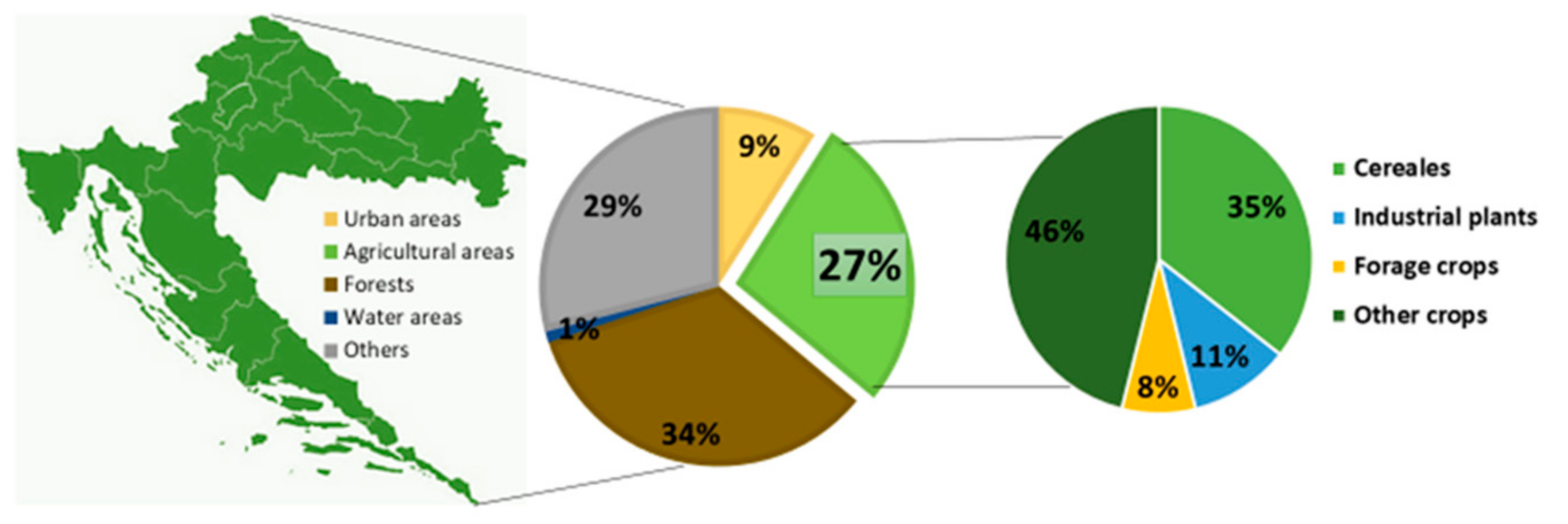
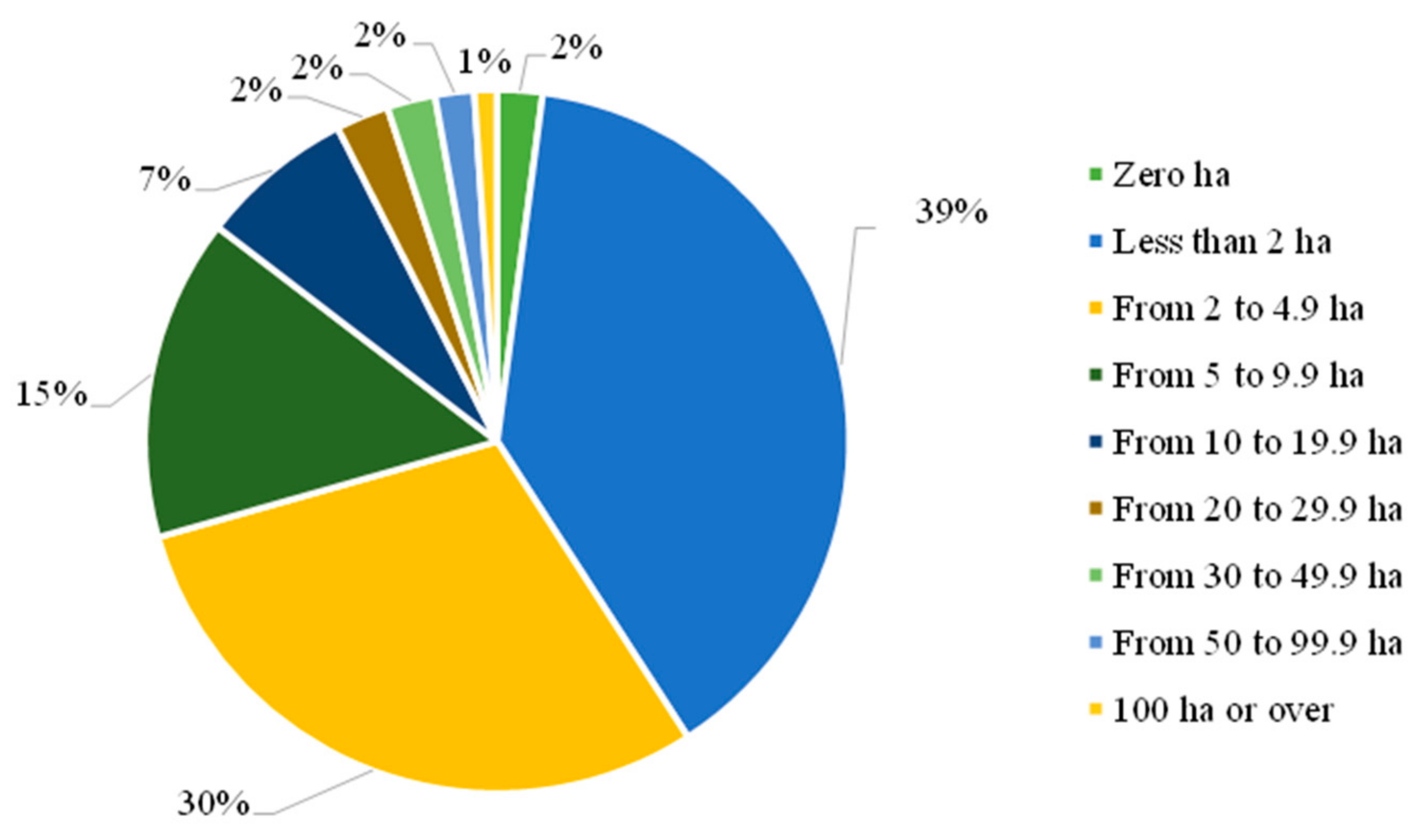
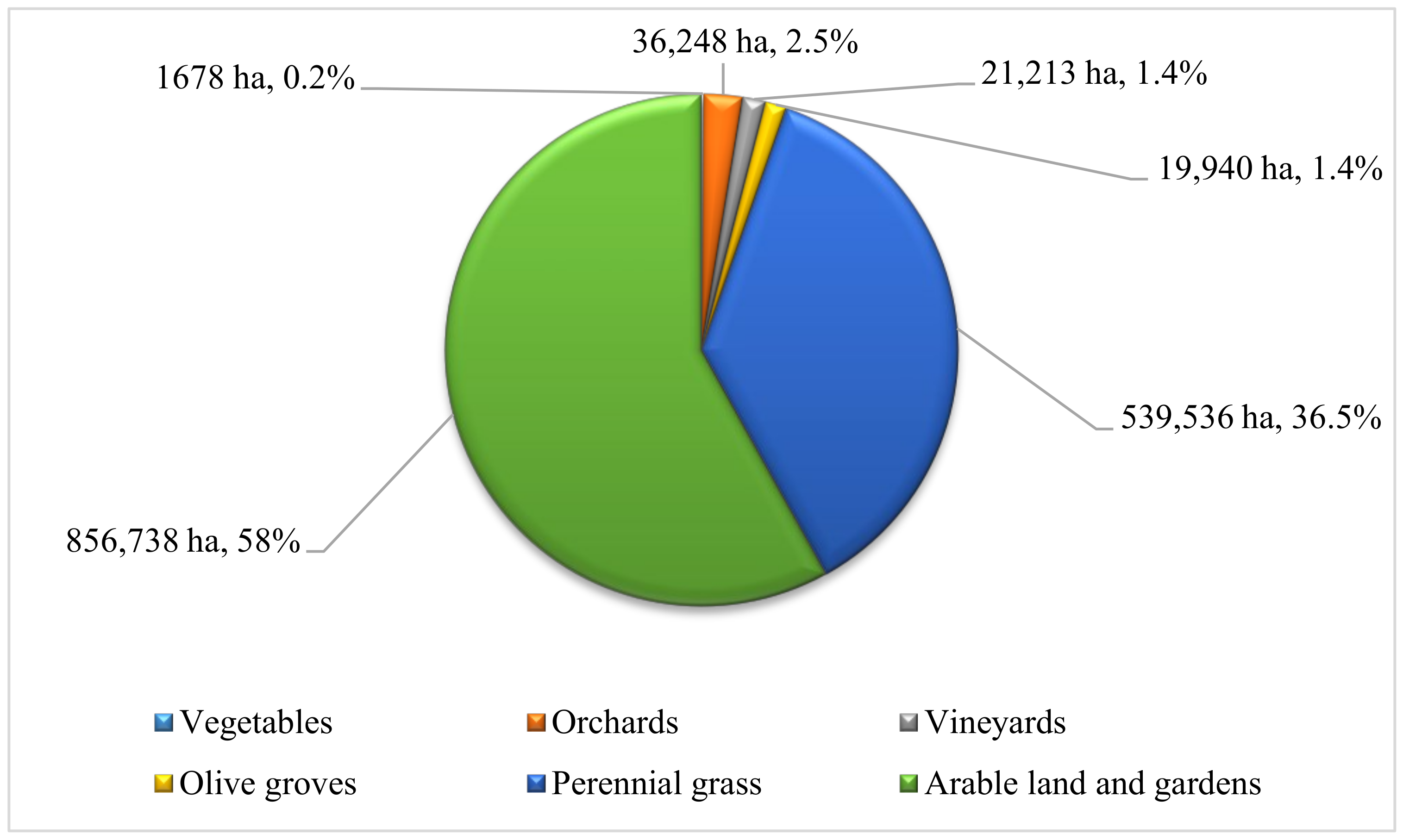
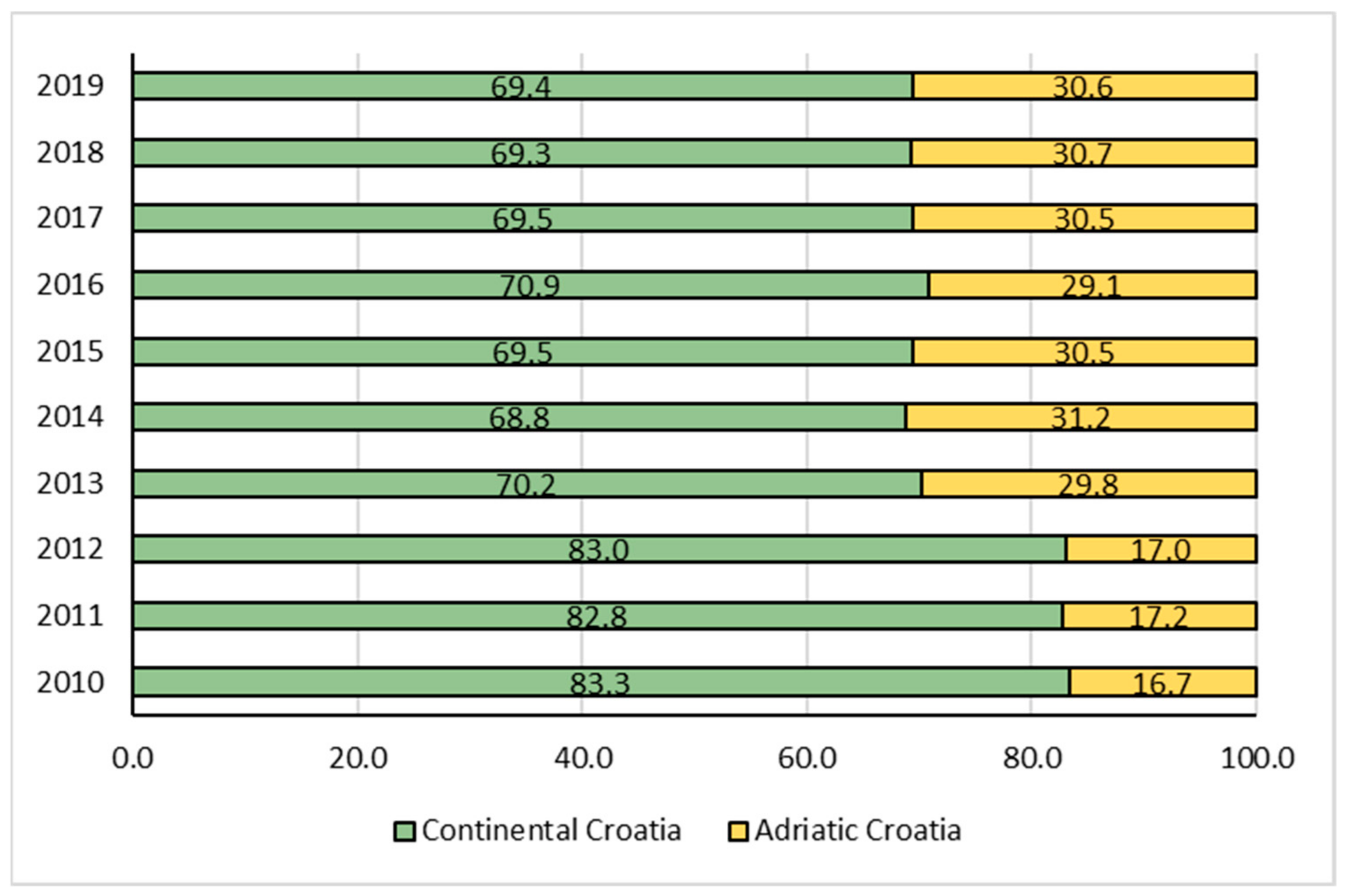

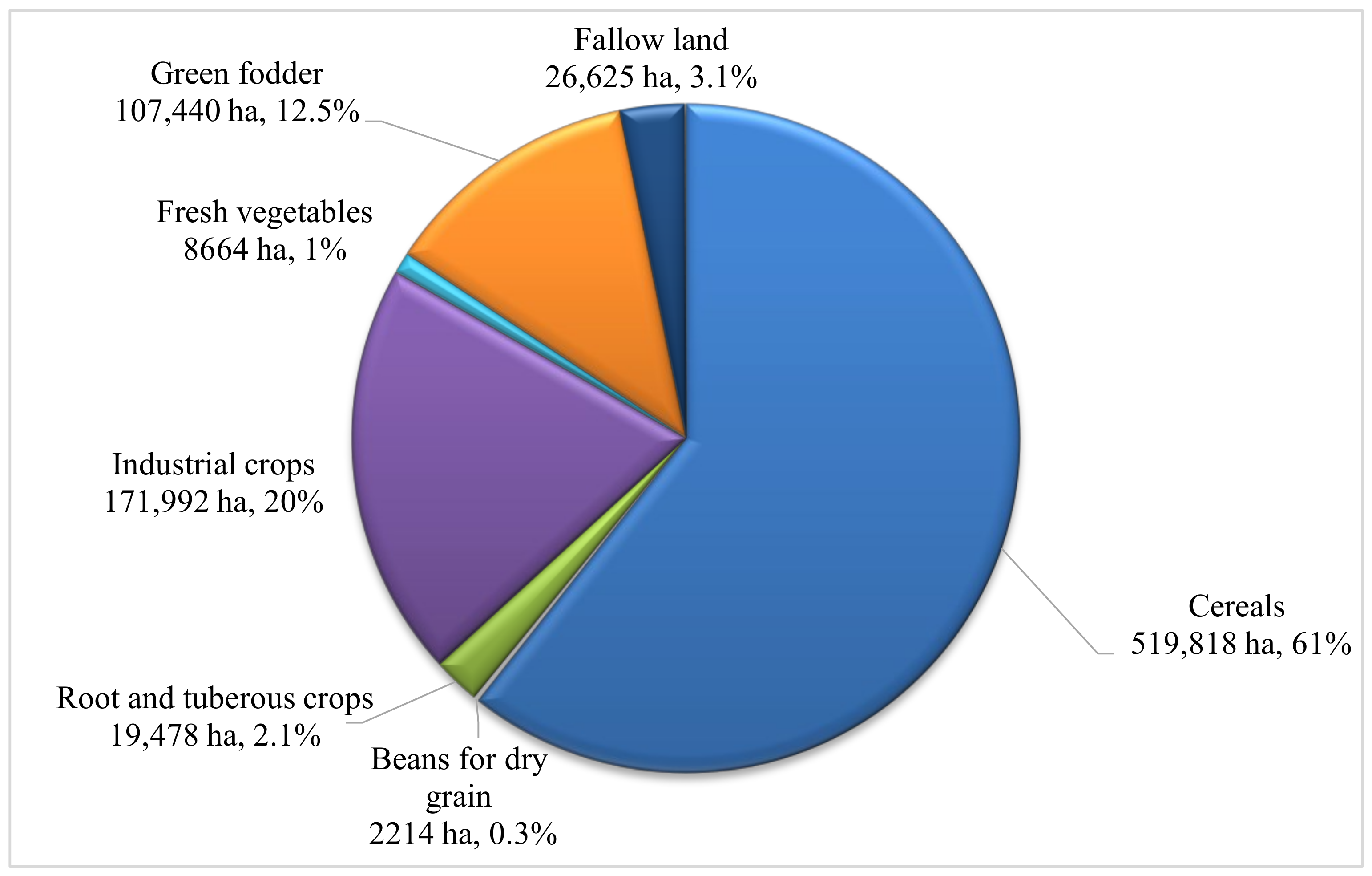
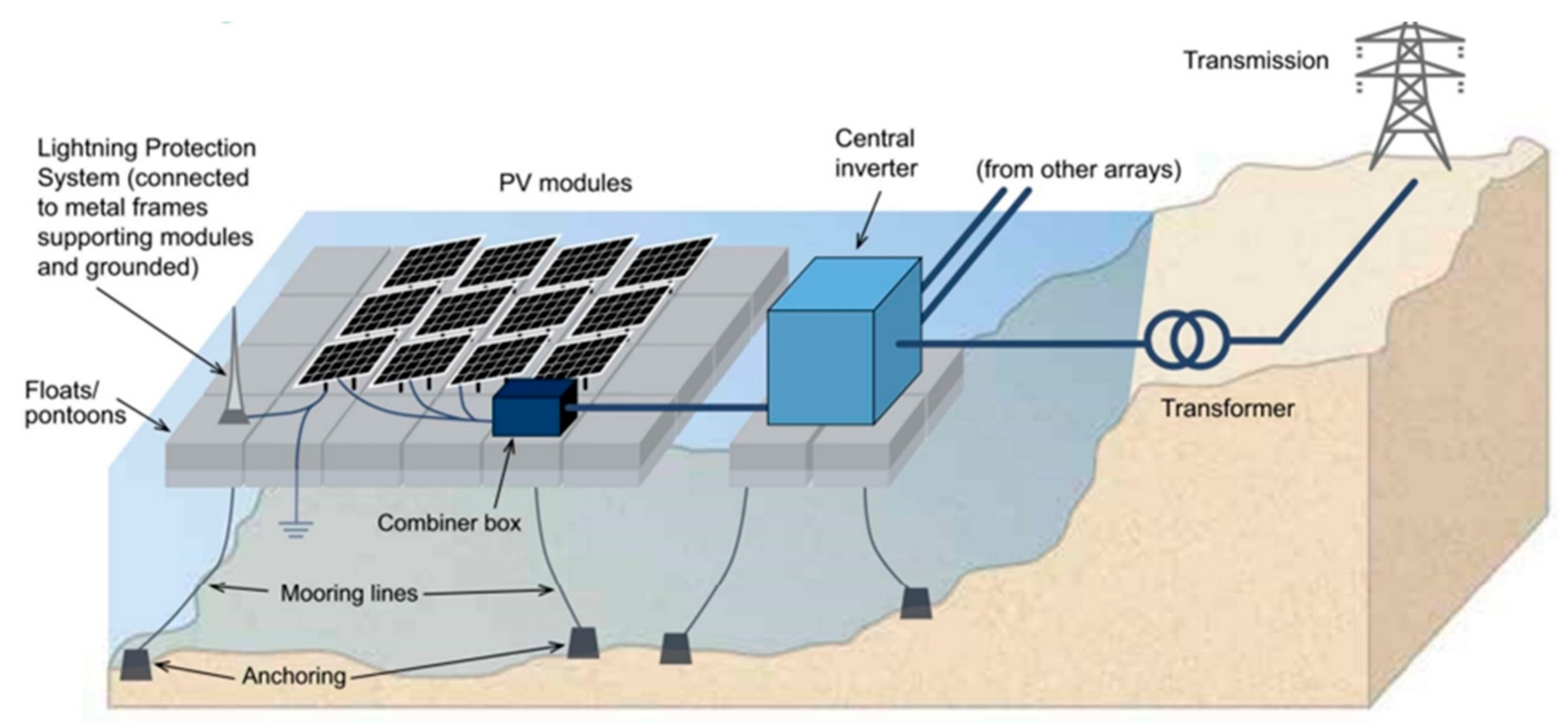
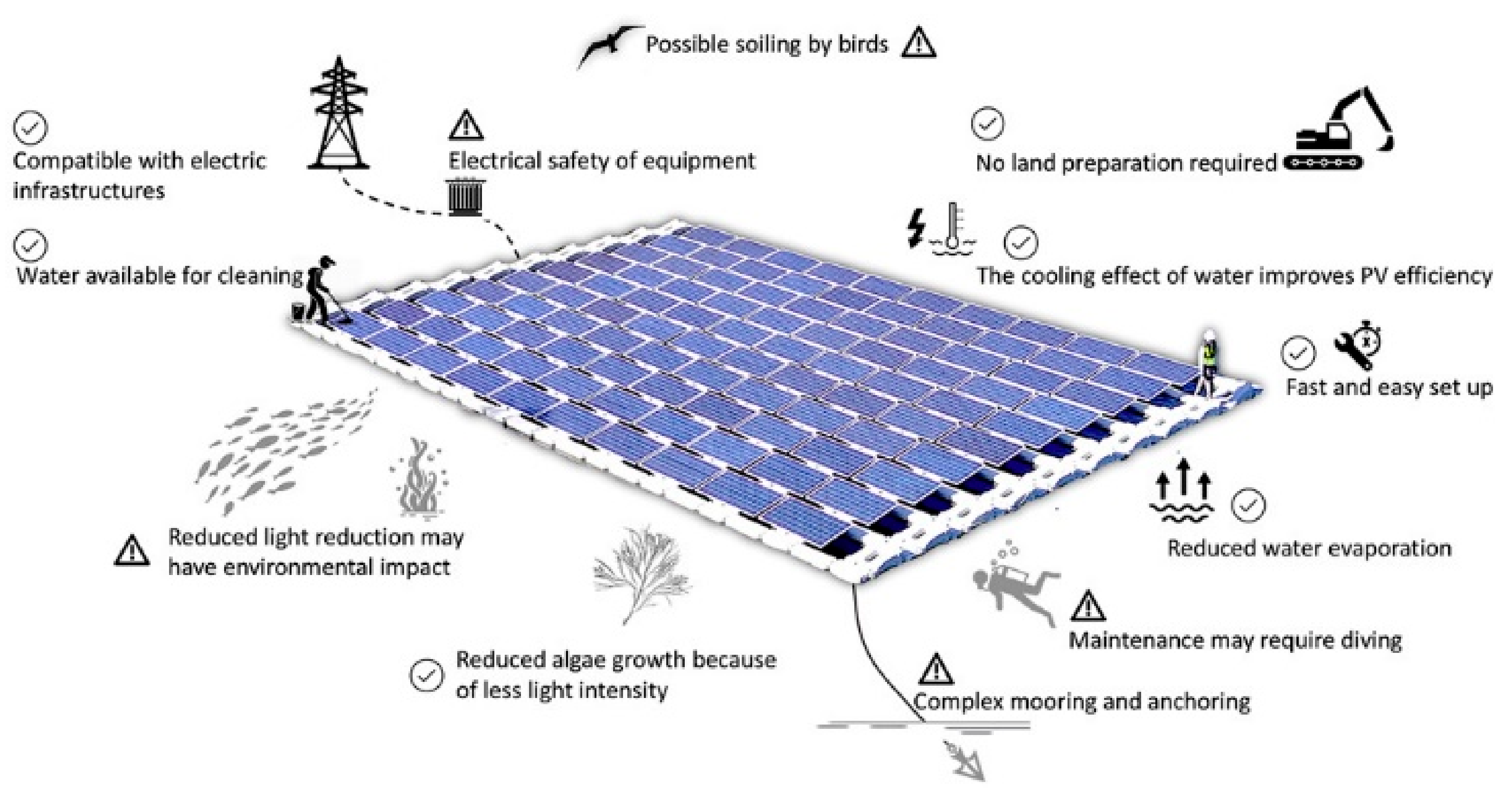
| Viticulture Plots (ha) | Area/No of Producers | Total | Share in Total Area (%) |
|---|---|---|---|
| <0.1 | Area (ha) | 837.50 | 4.73 |
| No. of producers | 13,075.00 | 39.09 | |
| 0.1–1 | Area (ha) | 4851.63 | 27.39 |
| No. of producers | 17,848.00 | 53.35 | |
| 1–5 | Area (ha) | 4257.83 | 24.03 |
| No. of producers | 2191.00 | 6.55 | |
| 5–10 | Area (ha) | 1351.11 | 7.63 |
| No. of producers | 197.00 | 0.59 | |
| 10–50 | Area (ha) | 2143.14 | 12.10 |
| No. of producers | 117.00 | 0.35 | |
| 50–100 | Area (ha) | 700.68 | 3.96 |
| No. of producers | 11.00 | 0.03 | |
| 100–200 | Area (ha) | 973.91 | 5.50 |
| No. of producers | 7.00 | 0.02 | |
| >200 | Area (ha) | 2599.50 | 14.67 |
| No. of producers | 6.00 | 0.02 | |
| Total Republic of Croatia | Area (ha) | 17,715.31 | 100 |
| No. of producers | 33,452.00 | 100 | |
| Avg. slope of the vineyard [%] | 6.38 |
| Crop | Area Harvested (ha) |
|---|---|
| Apples | 4390 |
| Pears | 750 |
| Plums and sloes | 3490 |
| Sour cherries | 2200 |
| Cherries | 1000 |
| Peaches and nectarines | 800 |
| Apricots | 310 |
| Strawberries | 270 |
| Blueberries | 380 |
| Other berries and fruits of the genus vaccinium n.e.c. | 1160 |
| Raspberries | 130 |
| Tangerines, mandarins, clementines | 2040 |
| Oranges | 40 |
| Lemons and limes | 60 |
| Walnuts (in shell) | 8420 |
| Hazelnuts (in shell) | 6710 |
| Almonds (in shell) | 810 |
| Chestnuts (in shell) | 280 |
| Olives | 19,940 |
| Figs | 570 |
| County | Orchard Size (ha) | |||||
|---|---|---|---|---|---|---|
| 0–1 | 1–5 | 5–20 | 20–100 | >100 | TOTAL | |
| Continental part | ||||||
| Bjelovarsko-bilogorska | 3906 | 926 | 61 | 1 | 0 | 4894 |
| Brodsko-posavska | 5850 | 656 | 53 | 13 | 0 | 6572 |
| Grad Zagreb | 1612 | 30 | 0 | 0 | 0 | 1642 |
| Karlovačka | 4314 | 547 | 33 | 3 | 0 | 4897 |
| Koprivničko-križevačka | 3859 | 294 | 13 | 3 | 0 | 4169 |
| Krapinsko-zagorska | 8261 | 56 | 0 | 0 | 0 | 8317 |
| Međimurska | 1628 | 255 | 21 | 0 | 0 | 1904 |
| Osječko-baranjska | 4042 | 1381 | 136 | 20 | 0 | 5579 |
| Požeško-slavonska | 4415 | 607 | 26 | 5 | 0 | 5053 |
| Sisačko-moslavačka | 4572 | 589 | 52 | 6 | 0 | 5219 |
| Varaždinska | 4694 | 137 | 5 | 0 | 0 | 4836 |
| Virovitičko-podravska | 2608 | 479 | 29 | 9 | 1 | 3126 |
| Vukovarsko-srijemska | 1981 | 465 | 50 | 12 | 0 | 2508 |
| Zagrebačka | 5995 | 326 | 42 | 4 | 0 | 6367 |
| 57,737 | 6748 | 521 | 76 | 1 | 65,083 | |
| Highlands/Coastal part * | ||||||
| Ličko-senjska | 4670 | 42 | 0 | 0 | 0 | 4712 |
| Primorsko-goranska | 805 | 15 | 1 | 0 | 0 | 821 |
| Šibensko-kninska | 1281 | 22 | 9 | 1 | 0 | 1313 |
| 6756 | 79 | 10 | 1 | 0 | 6846 | |
| Coastal part | ||||||
| Dubrovačko-neretvanska | 7929 | 360 | 3 | 0 | 0 | 8292 |
| Istarska | 1931 | 68 | 5 | 1 | 0 | 2005 |
| Splitsko-dalmatinska | 3900 | 28 | 9 | 1 | 0 | 3938 |
| Zadarska | 4807 | 167 | 29 | 5 | 0 | 5008 |
| 18,567 | 623 | 46 | 7 | 0 | 19,243 | |
| TOTAL | 83,060 | 7450 | 577 | 84 | 1 | 91,172 |
| Total Area (ha) | Agricultural Activity | Average Area (ha) | Agricultural Activity >1 ha | Agricultural Activity >10 ha | |
|---|---|---|---|---|---|
| Olive | 14,225.35 | 14,187 | 1.00 | 180 | 15 |
| Mandarin | 1589.87 | 1335 | 1.19 | 13 | 1 |
| Lemon | 31.92 | 201 | 0.16 | 1 | 0 |
| Orange | 14.96 | 92 | 0.16 | 0 | 0 |
| Kumquat | 0.60 | 10 | 0.06 | 0 | 0 |
| Grapefruit | 0.10 | 3 | 0.03 | 0 | 0 |
| Almond | 738.34 | 1041 | 0.71 | 33 | 5 |
| Marasca sour cherry | 347.09 | 236 | 1.47 | 8 | 4 |
| Fig | 303.96 | 813 | 0.37 | 31 | 1 |
| Pomegranate | 55.18 | 172 | 0.32 | 5 | 0 |
| Carob | 50.61 | 14 | 3.62 | 1 | 1 |
| Kiwifruit | 15.95 | 14 | 1.14 | 1 | 1 |
| Jujube | 3.01 | 12 | 0.25 | 0 | 0 |
| Mixed fruit Cultivation | 1273.31 | 3994 | 0.32 | 16 | 3 |
| Fruit nurseries | 17.28 | 18 | 0.96 | 3 | 0 |
| TOTAL | 18,667.53 | 22,142 | 0.84 | 292 | 31 |
| Total Area (ha) | Agricultural Activity | Average Area (ha) | Agricultural Activity >1 ha | Agricultural Activity >10 ha | |
|---|---|---|---|---|---|
| Istria County | 3171.84 | 2492 | 1.27 | 68 | 6 |
| Primorje-Gorski Kotar County | 562.05 | 495 | 1.14 | 19 | 0 |
| Lika-Senj County | 121.93 | 96 | 1.27 | 1 | 0 |
| Zadar County | 2625.96 | 3522 | 0.75 | 23 | 6 |
| Šibenik-Knin County | 2061.95 | 2082 | 0.99 | 28 | 0 |
| Split-Dalmatia County | 3511.11 | 2728 | 1.29 | 28 | 1 |
| Dubrovnik-Neretva County | 2170.51 | 2772 | 0.78 | 22 | 2 |
| TOTAL | 14,225.34 | 14,187 | 1.00 | 180 | 15 |
| Area (ha) | Production (t) | Yield (t/ha) | |
|---|---|---|---|
| Total fresh vegetables (including kitchen gardens) | 10,076 | 214,374 | 21.3 |
| Total fresh vegetables | 8398 | 168,624 | 20.1 |
| Cauliflower and broccoli | 195 | 3154 | 16.2 |
| Cabbage (white and red) | 1201 | 28,844 | 24 |
| Other brassicas | 146 | 2536 | 17.4 |
| Leeks | 97 | 1697 | 17.5 |
| Lettuce | 195 | 3586 | 18.4 |
| Lettuce under glass | 31 | 701 | 22.6 |
| Other leafy or stalked vegetables | 520 | 6419 | 12.3 |
| Tomatoes | 292 | 18,785 | 64.3 |
| Tomatoes for fresh consumption | 64 | 1316 | 20.6 |
| Tomatoes under glass | 88 | 11,902 | 135.3 |
| Cucumbers and gherkins | 98 | 8549 | 87.2 |
| Cucumbers and gherkins under glass | 43 | 7554 | 175.7 |
| Melons | 132 | 1852 | 14 |
| Watermelons | 720 | 21,476 | 29.8 |
| Red peppers, capsicum | 803 | 13,559 | 16.9 |
| Red peppers and capsicum under glass | 31 | 1778 | 57.4 |
| Other vegetables cultivated for fruit | 1327 | 17,938 | 13.5 |
| Carrots | 306 | 6403 | 20.9 |
| Onions and garlic | 914 | 19,044 | 20.8 |
| Beetroot | 126 | 3173 | 25.2 |
| Other root and tuber vegetables | 289 | 4107 | 14.2 |
| Green peas | 563 | 4600 | 8.2 |
| Green beans | 474 | 2902 | 6.1 |
| Fresh vegetables (kitchen gardens) | 1678 | 45,750 | 27.3 |
| Total Area (ha) | Agricultural Activity | Average Area (ha) | Agricultural Activity >1 ha | Agricultural Activity >10 ha | |
|---|---|---|---|---|---|
| Zagreb County | 41.64 | 13 | 3.20 | 8 | 1 |
| Sisak-Moslavina County | 346.37 | 17 | 20.37 | 14 | 7 |
| Karlovac County | 0.23 | 1 | 0.23 | 0 | 0 |
| Koprivnica-Križevci County | 115.30 | 18 | 6.41 | 17 | 2 |
| Bjelovar-Bilogora County | 219.61 | 10 | 21.97 | 10 | 7 |
| Primorje-Gorski Kotar County | 1.06 | 1 | 1.06 | 1 | 0 |
| Virovitica-Podravina County | 4137.89 | 361 | 11.46 | 351 | 123 |
| Požega-Slavonia County | 45.97 | 5 | 9.19 | 5 | 1 |
| Brod-Posavina County | 8.10 | 5 | 1.62 | 3 | 0 |
| Osijek-Baranja County | 1400.21 | 61 | 22.95 | 58 | 36 |
| Vukovar-Syrmia County | 22.38 | 3 | 7.46 | 3 | 1 |
| Istria County | 1.75 | 1 | 1.75 | 1 | 0 |
| Dubrovnik-Neretva County | 0.75 | 1 | 0.75 | 0 | 0 |
| Međimurje County | 2.02 | 2 | 1.01 | 1 | 0 |
| City of Zagreb | 16.54 | 4 | 4.14 | 3 | 0 |
| TOTAL | 6359.92 | 503 | 12.64 | 475 | 178 |
| Area (ha) | Production (t) | Yield (t/ha) | |
|---|---|---|---|
| Cereals | |||
| Grain maize | 287,976 | 2,242,119 | 7.8 |
| Wheat | 143,535 | 961,940 | 6.7 |
| Rye | 511 | 2082 | 4.1 |
| Barley | 56,478 | 306,209 | 5.4 |
| Oats | 17,063 | 58,840 | 3.4 |
| Triticale | 9386 | 42,497 | 4.5 |
| Other cereals | 4869 | 15,463 | 3.2 |
| Industrial plants | |||
| Soybean | 86,259 | 227,872 | 2.6 |
| Sunflower seed | 40,969 | 124,363 | 3.0 |
| Rapeseed | 30,281 | 73,423 | 2.4 |
| Other oil seeds | 4098 | 3548 | 0.9 |
| Sugar beet | 10,066 | 707,000 | 70.2 |
| Potatoes | 8786 | 127,826 | 14.5 |
| Tobacco | 3488 | 7384 | 2.1 |
| Fodder crops | |||
| Green maize | 25,133 | 873,179 | 34.7 |
| Other annual green fodder | 5794 | 91,218 | 15.7 |
| Alfalfa | 28,128 | 179,680 | 6.4 |
| Clover and mixtures | 8425 | 46,986 | 5.6 |
| Other leguminous plants harvested green | 11,283 | 83,764 | 7.4 |
| Fodder peas | 792 | 2331 | 2.9 |
| Meadow | Pasture | Karst Pasture | |||
|---|---|---|---|---|---|
| Total Surface (ha) | Number of Parcels | Total Surface (ha) | Number of Parcels | Total Surface (ha) | Number of Parcels |
| 101,632.95 | 242,376 | 25,313.13 | 16,479 | 91,498.52 | 56,051 |
| Type of Agricultural Holding | Continental Pasture (ha) | Karst Pasture (ha) | Meadows (ha) |
|---|---|---|---|
| Family farm | 20,244.76 | 78,388.62 | 76,266.18 |
| Craft | 863.71 | 913.10 | 2259.69 |
| Other legal entities (church, army, educational institutions) | 134.01 | 272.47 | 244.13 |
| Self-sufficient agricultural holding | 401.6 | 1581.86 | 12,100.29 |
| Company | 2656.62 | 7447.78 | 2698.5 |
| Cooperative | 301.98 | 3329.81 | 256.66 |
| TOTAL | 24,602.68 | 91,933.64 | 93,825.45 |
| County | Area (ha) |
|---|---|
| Bjelovar-Bilogora | 3267.04 |
| City of Zagreb * | 1273.69 |
| Požega-Slavonia/Bjelovar-Bilogora | 1274.659 |
| Osijek-Baranja | 2920.31 |
| Karlovac | 391.78 |
| Virovitica-Podravina | 981.22 |
| Sisak-Moslavina | 742.15 |
| Brod-Posavina | 3069.95 |
| Zagreb/Bjelovar-Bilogora | 117.99 |
| Varaždin | 4.72 |
| Međimurje | 5.75 |
| Požega-Slavonia | 0.44 |
| Species | 2017 | 2018 | 2019 | 2020 | 2021 |
|---|---|---|---|---|---|
| Common carp | 2039 | 1959 | 2037 | 1691 | 2738 |
| Grass carp | 169 | 141 | 122 | 133 | 266 |
| Silver carp | 73 | 36 | 141 | 161 | 212 |
| Big-head carp | 477 | 301 | 344 | 326 | 414 |
| Catfish | 31 | 23 | 20 | 32 | 32 |
| Sander | 9 | 7 | 7 | 6 | 4 |
| Pike | 12 | 7 | 9 | 2 | 3 |
| Rainbow trout | 395 | 336 | 364.5 | 379 | 335.6 |
| Brown trout | 34 | 7.5 | 12.4 | 15 | |
| Other | 67 | 55 | 48 | 37 | 22 |
| TOTAL (t) | 3272 | 2899 | 3100 | 2779 | 4040 |
Disclaimer/Publisher’s Note: The statements, opinions and data contained in all publications are solely those of the individual author(s) and contributor(s) and not of MDPI and/or the editor(s). MDPI and/or the editor(s) disclaim responsibility for any injury to people or property resulting from any ideas, methods, instructions or products referred to in the content. |
© 2023 by the authors. Licensee MDPI, Basel, Switzerland. This article is an open access article distributed under the terms and conditions of the Creative Commons Attribution (CC BY) license (https://creativecommons.org/licenses/by/4.0/).
Share and Cite
Matulić, D.; Andabaka, Ž.; Radman, S.; Fruk, G.; Leto, J.; Rošin, J.; Rastija, M.; Varga, I.; Tomljanović, T.; Čeprnja, H.; et al. Agrivoltaics and Aquavoltaics: Potential of Solar Energy Use in Agriculture and Freshwater Aquaculture in Croatia. Agriculture 2023, 13, 1447. https://doi.org/10.3390/agriculture13071447
Matulić D, Andabaka Ž, Radman S, Fruk G, Leto J, Rošin J, Rastija M, Varga I, Tomljanović T, Čeprnja H, et al. Agrivoltaics and Aquavoltaics: Potential of Solar Energy Use in Agriculture and Freshwater Aquaculture in Croatia. Agriculture. 2023; 13(7):1447. https://doi.org/10.3390/agriculture13071447
Chicago/Turabian StyleMatulić, Daniel, Željko Andabaka, Sanja Radman, Goran Fruk, Josip Leto, Jakša Rošin, Mirta Rastija, Ivana Varga, Tea Tomljanović, Hrvoje Čeprnja, and et al. 2023. "Agrivoltaics and Aquavoltaics: Potential of Solar Energy Use in Agriculture and Freshwater Aquaculture in Croatia" Agriculture 13, no. 7: 1447. https://doi.org/10.3390/agriculture13071447
APA StyleMatulić, D., Andabaka, Ž., Radman, S., Fruk, G., Leto, J., Rošin, J., Rastija, M., Varga, I., Tomljanović, T., Čeprnja, H., & Karoglan, M. (2023). Agrivoltaics and Aquavoltaics: Potential of Solar Energy Use in Agriculture and Freshwater Aquaculture in Croatia. Agriculture, 13(7), 1447. https://doi.org/10.3390/agriculture13071447









